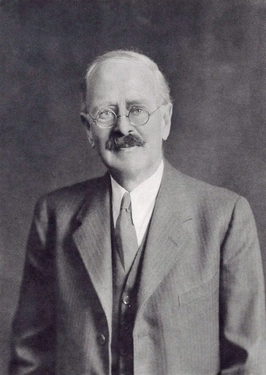Arthur Stewart Eve facts for kids
Quick facts for kids
Arthur Stewart Eve
|
|
|---|---|
 |
|
| Born | 22 November 1862 Silsoe
|
| Died | 24 March 1948 (aged 85) Puttenham, Surrey
|
| Resting place | St James the Great Churchyard, Silsoe |
| Alma mater | Pembroke College, Cambridge |
| Known for | Authoritative biography of Rutherford |
| Spouse(s) | Elizabeth Agnes Brooks |
| Children | Richard, Joan and Cicely |
| Scientific career | |
| Fields | Radioactivity |
| Institutions | Marlborough College McGill University Admiralty Experimental Station |
Arthur Stewart Eve (born November 22, 1862 – died March 24, 1948) was an important English physicist. He spent a big part of his career working in Canada. He is best known for his work on radioactivity and for writing a detailed book about his famous colleague, Ernest Rutherford.
Contents
A Life in Science
Arthur Stewart Eve was born in Silsoe, England, on November 22, 1862. His father was a surveyor. Arthur went to Berkhamsted School and then studied at Pembroke College, Cambridge. He finished his studies in 1884.
From 1886 to 1902, Eve worked as a teacher at Marlborough College. He also managed the school's finances for some years. In 1903, he decided to move to North America. He sailed to New York and then traveled to McGill University in Canada.
At McGill, he started as a math lecturer. Soon, he joined the physics department. There, he began working with the famous scientist Ernest Rutherford. Their early research together focused on radioactivity. Eve's first papers were published in 1904. Because of his successful work, he became an Associate Professor of Physics in 1909. The next year, he was chosen as a Fellow of the Royal Society of Canada.
Helping During Wartime
When the First World War began, Eve joined the military. He was a major in the Canadian forces. By 1917, he was 55 years old. Sir William Bragg, another famous physicist, asked him to take on a special role. Eve became the Director of the Admiralty Experimental Station in Harwich, England. His team there worked on important ways to find and detect submarines.
In the same year, Eve was also made a Fellow of the Royal Society, a very high honor for scientists. In 1918, he received the CBE award and became a colonel in the Canadian military.
Back to McGill
After the war, in 1919, Eve returned to McGill University. He became the Director of Physics. He worked hard to rebuild the department, making it strong again. He brought in other talented scientists to help with research. He held this important position until 1935.
Eve also wrote scientific books. With his colleague David Keys, he published "Applied Geophysics" in 1932. He also co-wrote "College Physics" in 1935. He retired in 1935 and was given the title of Professor Emeritus of Physics. This means he was honored for his long service.
Writing About Scientists
After retiring, Eve moved to London. When Ernest Rutherford passed away in 1937, Eve was asked to write his life story. He had worked closely with Rutherford, so he knew him well. The book was published in 1939.
Eve then started writing about another Irish physicist, John Tyndall. He finished the first draft, but he had a stroke and could not finish the book himself. Another person, C. H. Creasey, completed it, and it was published in 1945.
Family Life
Arthur Stewart Eve married Elizabeth Agnes Brooks in 1905. She was also a graduate of McGill University. They had three children: Richard Stewart, Joan, and Cicely Somers.
Arthur Stewart Eve died in Puttenham, Surrey on March 24, 1948. He was buried in the churchyard of St James the Great Church, in his hometown of Silsoe.
Positions Held
Here are some of the important roles Arthur Stewart Eve held during his career:
- Assistant Master at Marlborough College (1886–1902)
- Lecturer in Mathematics at McGill University (1903)
- Associate Professor of Physics at McGill University (1909)
- Fellow of the Royal Society of Canada (1910)
- Director of Research at the Admiralty Experimental Station (1917–1918)
- Colonel in the Canadian Expeditionary Force (1918)
- Director of Physics at McGill University (1919–1935)
- President of the Royal Society of Canada (1929–1930)
- Professor Emeritus of Physics at McGill University
See Also

